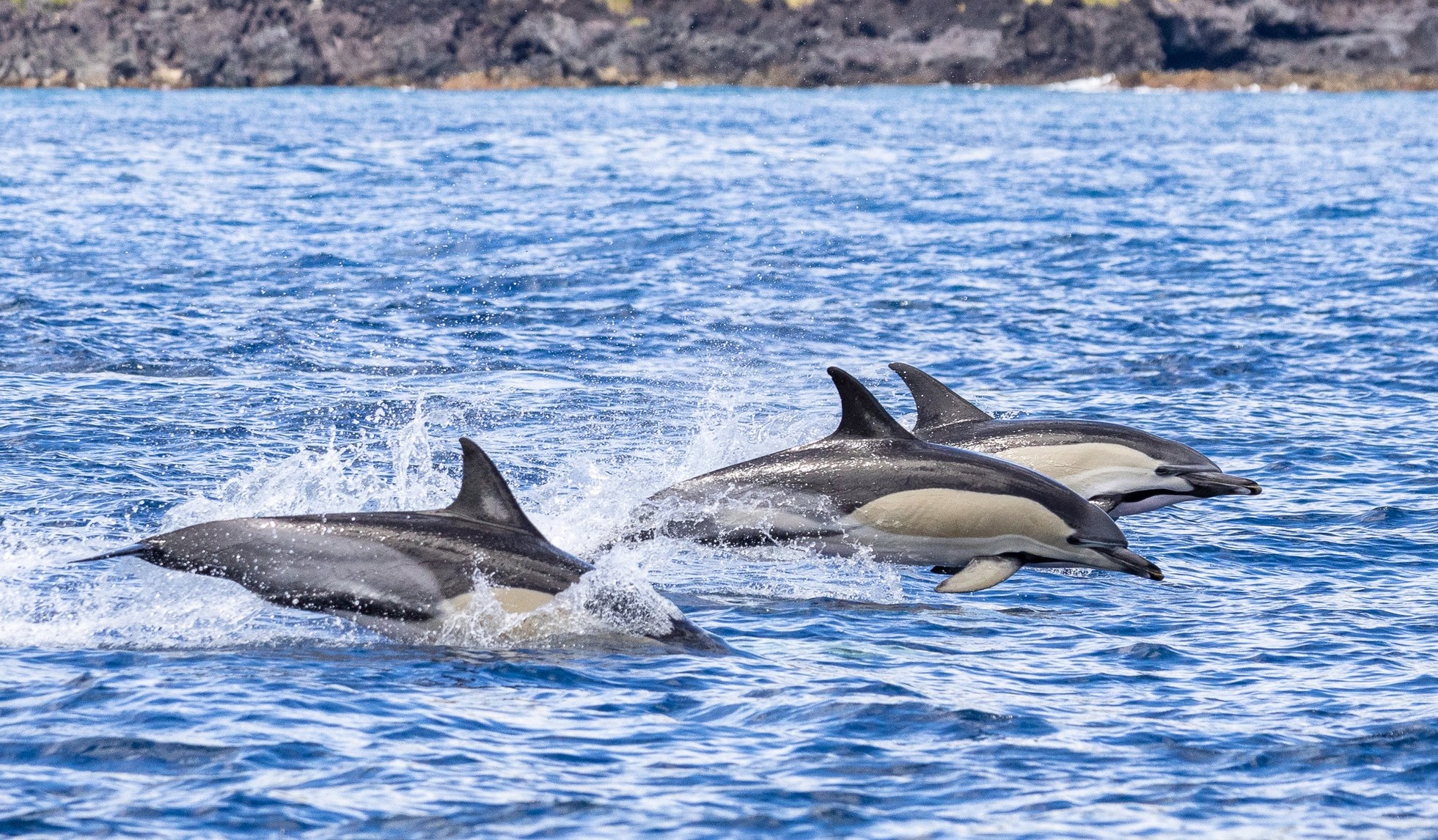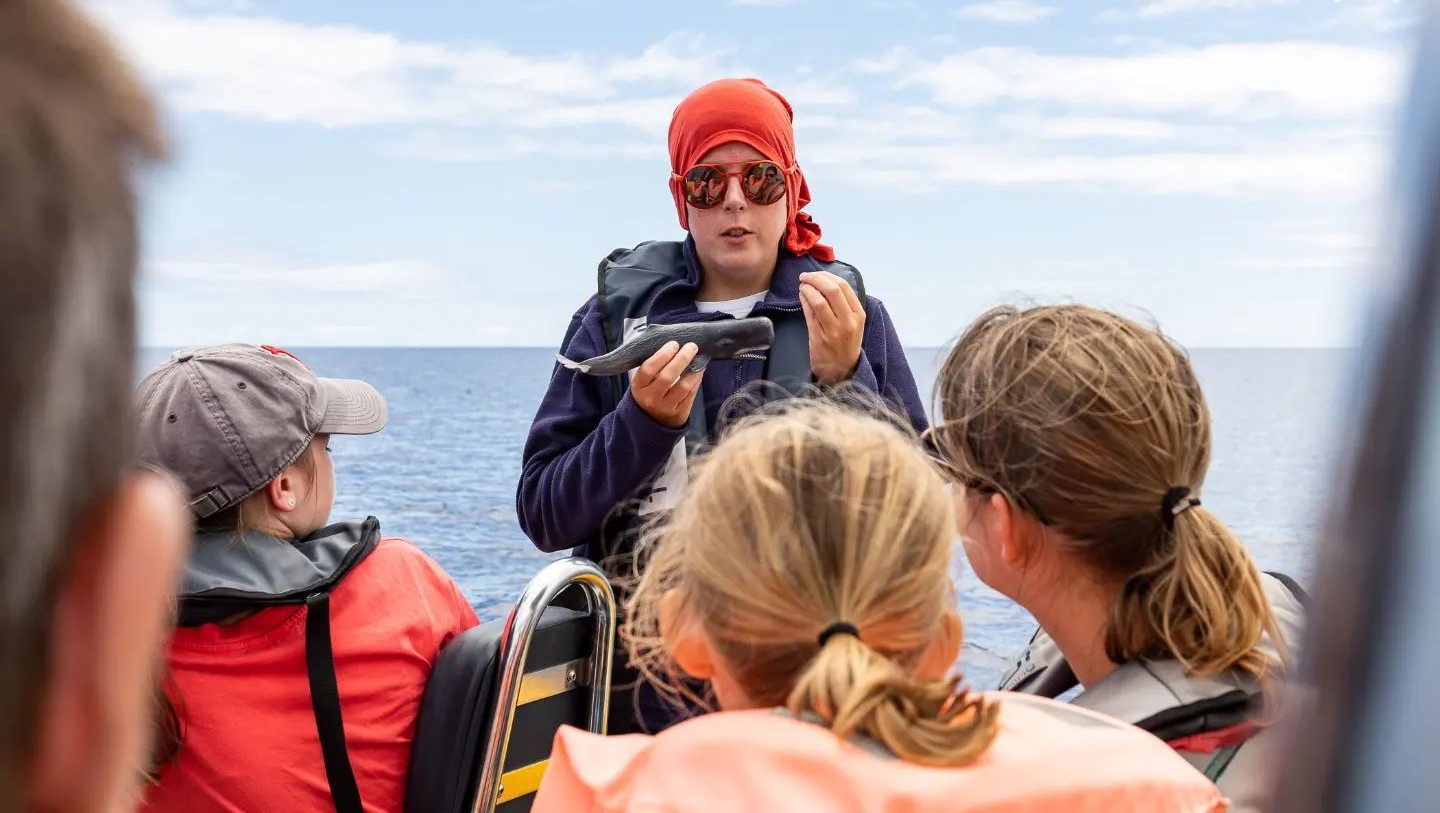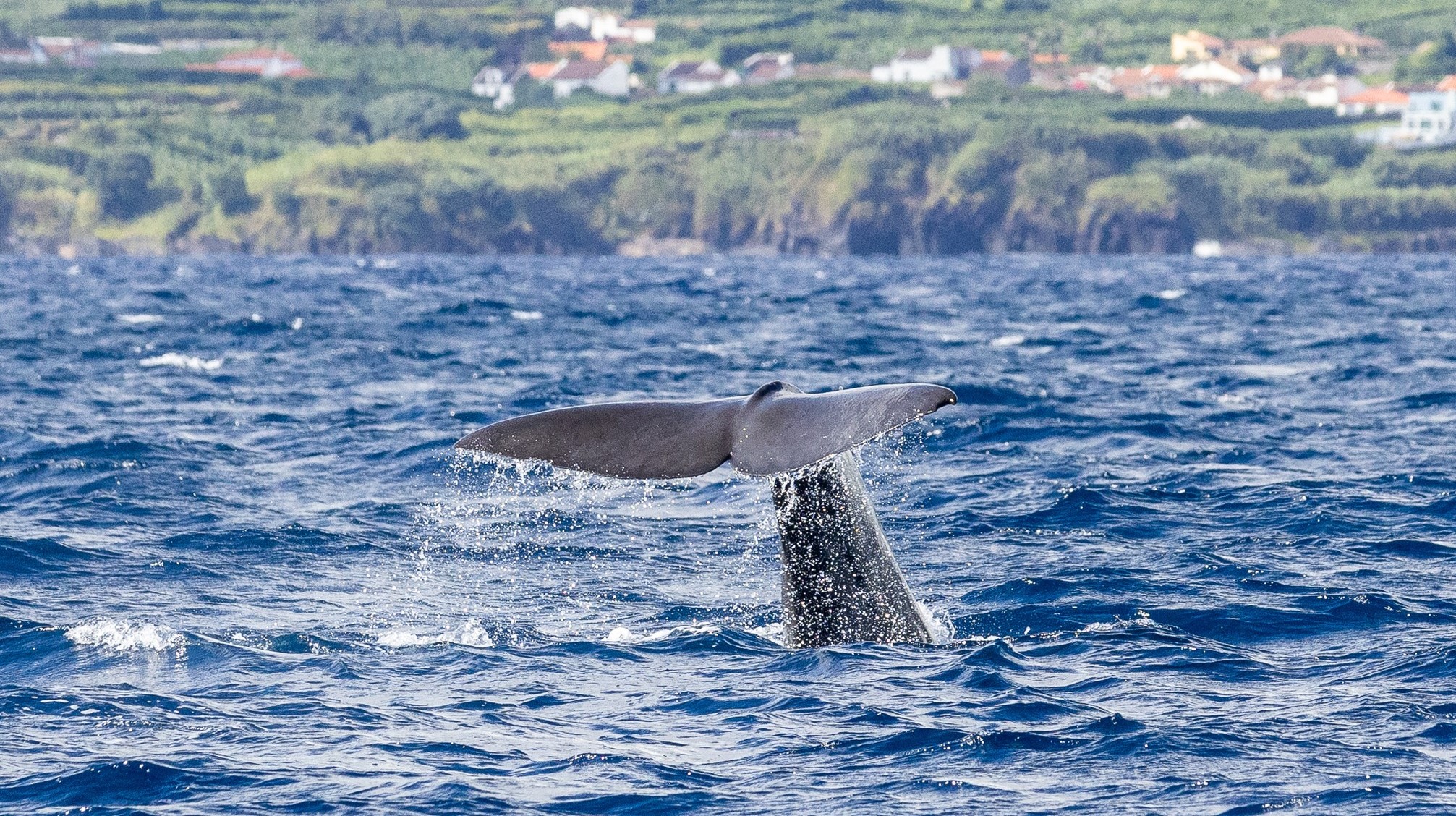Whales and Birds of Sao Miguel
2024 sees the return for one of our most-popular holidays: say hello to the Whales and Birds of Sao Miguel...
You are here: Home > The Azores > Whales and Birds of Sao Miguel
2024 sees the return for one of our most-popular holidays: say hello to the Whales and Birds of Sao Miguel.
 Having taking their first tentative steps into the world of eco-tourism in the 1980s, the islands of the Azores are now widely considered to be Europe’s number one destination for whale and dolphin watching.
Having taking their first tentative steps into the world of eco-tourism in the 1980s, the islands of the Azores are now widely considered to be Europe’s number one destination for whale and dolphin watching.
 Whale-tourism is now key to the ecology of the north Atlantic, helping to support cetacean studies and conservation across the Azores. And trips to sea are so much more than simply watching whales – in the capable hands of our resident marina biologists, you’ll learn about the habitats of the Azorean populations of Sperm whales, the behavioural patterns of bottlenose dolphins, and different ways cetacean species communicate.
Whale-tourism is now key to the ecology of the north Atlantic, helping to support cetacean studies and conservation across the Azores. And trips to sea are so much more than simply watching whales – in the capable hands of our resident marina biologists, you’ll learn about the habitats of the Azorean populations of Sperm whales, the behavioural patterns of bottlenose dolphins, and different ways cetacean species communicate.
 Thanks to their mid-Atlantic location, the Azores are also home to a wide variety of marine birds, migratory species and occasionally the odd vagrant. Shearwaters and storm-petrels are regular visitors to the Ilhue d’ Vila: an extinct offshore volcano and nature reserve which you’ll have a chance to visit. On land, you’ll also explore eastern Sao Miguel’s laurisilva forests: the protected natural habitat for one of Europe’s most-endangered native bird species: the Priolo bullfinch.
Thanks to their mid-Atlantic location, the Azores are also home to a wide variety of marine birds, migratory species and occasionally the odd vagrant. Shearwaters and storm-petrels are regular visitors to the Ilhue d’ Vila: an extinct offshore volcano and nature reserve which you’ll have a chance to visit. On land, you’ll also explore eastern Sao Miguel’s laurisilva forests: the protected natural habitat for one of Europe’s most-endangered native bird species: the Priolo bullfinch.
 We’ll also include a hire car to allow you to explore the magnificent landscapes of Sao Miguel at your leisure: the beautiful twin lakes at Sete Cidades, the central Fogo volcanic massif, and the hot springs and geothermal pools in Furnas.
We’ll also include a hire car to allow you to explore the magnificent landscapes of Sao Miguel at your leisure: the beautiful twin lakes at Sete Cidades, the central Fogo volcanic massif, and the hot springs and geothermal pools in Furnas.

Day 1
You’ll begin your holiday by flying from Heathrow to the Azores, via Lisbon. Our driver will collect you on arrival for the twenty-minute transfer to your accommodation at Quinta do Mar in the south coast village of Caloura.
Day 2
We’ll deliver a hire car and you’ll drive to the nearby town of Vila Franca do Campo for a three-hour whale and dolphin watching trip. The seas around the Azores are one of the best places to observe cetaceans and other ocean wildlife: bottlenose dolphins, sperm whales leatherback turtles, blue sharks, storm petrels and Cory’s shearwaters.
Day 3
You’ll return to Vila Franca this morning for a second whale and dolphin watching trip. You’ll also explore Ponta Delgada, capital of the Azores and the main town on the island. With its narrow, cobbled streets, mosaic pavements and interesting mix of traditional and modern architecture, it’s a nicely compact city which is easy to explore on foot.
Day 4
You’ll head to the sparsely populated eastern end of the island, home to the Priolo: the Azorean bullfinch. Our resident birding guide will take you deep into the laurisilva forests, where you’ll learn more about this endangered species and the attempts to conserve its natural habitat.
Day 5
You’ll spend a day in the Furnas valley, famous for its hot springs, geysers and geothermal swimming pools.
Day 6
You’ll return to sea this morning, concentrating Sao Miguel’s marina bird population. Thanks to their mid-Atlantic location, the Azores are a welcome refuge for a wide variety of marine birds: great shearwaters, manx shearwaters and leach’s storm-petrels are regulars, and vagrant arctic, pomarine and great skuas are surprise rarities.
Day 7
You’ll return to the marina for your third and final whale watching trip. In the afternoon, you’ll head west to explore the great crater at Sete Cidades, ending the day with a swim at Ponta da Ferraria, where the sea is naturally heated by underwater volcanic vents.
Day 8
You’ll return your hire car to the airport before flying home.
Our holidays have a nice balance of activities and free time. Everything’s flexible and you can personalise your trip.
Whale watching
The Azores are one of the premier whale and dolphin watching destinations in the world, with a wide range of species including resident sperm and pilot whales, migratory blue and fin whales, and bottlenose and spotted dolphins.
Walking
Walking is one of the best ways to explore the Azores, and there are guided and self guided walks to suit everyone's level of fitness.
Canyoning
Canyoning is fast growing in popularity and the Azores have excellent routes on Sao Miguel, Sao Jorge and Flores.
Cycling and mountain biking
Cycle from village to village along the quiet roads or take an adrenaline fuelled guided mountain biking ride down from the crater lakes, the Azores have lots of exciting two wheel options.
Jeep tours
Get off-road with our friendly knowledgeable guides along the dirt tracks of the Azores.
Kayaking and Paddle boarding
Kayak and paddleboard on the breathtaking crater lakes or along the rugged coastline of Sao Miguel and Terceira.
Horse riding
From one hour lessons in an indoor arena to full day rides, riding is one of the best ways to explore the Azorean countryside. You'll be riding beautiful pure and cross bred Lusitano horses and be in the safe hands of our experienced guides.
Surfing
With its year round mild climate and sea temperatures, the Azores is starting to become more popular with surfers. Working with a school on the north coast of Sao Miguel, we can provide lessons with our friendly instructors or just hire the boards and wetsuits and ride the waves on your own.
Diving
As well as offering unique diving experiences for qualified divers, beginners can also learn at the excellent schools on the islands. Dive sites are varied from offshore reefs and volcanic caves to drop-offs, impressive arches and flat seabed. Most dives rarely go deeper than 15m and average sea temperatures are 17-22°C. Visibility is very good at 20-25m.
Birdwatching
With close to 400 species sighted in the archipelago, this is a rewarding yet quiet bird watching destination. For many the highlight is spotting the endemic Azores Bullfinch found only in a small part of the main island of Sao Miguel. There's also the large Cory Shearwater and Roseate Tern colonies, Atlantic canary, several subspecies of the Common Chaffinch, the São Miguel Goldcrest and the Azores Woodpigeon. In October, the Azores become the undisputed rarity hotspot of the Western Palearctic with a wealth of America vagrants on offer from shorebirds and wildfowl to wood-warblers and vireos.
Golf
Golfing in the Azores is a real pleasure. Courses are quiet and spectacular offering views over the ocean and volcanic craters. On São Miguel, Batalha overlooks the sea and is the newest and most challenging course while Furnas (located in the mountains at an altitude of 500m) is sprinkled with lakes and stands of Japanese Cryptomeria and then there's the heavily wooded course on Terceira close the beautiful town of Angra.
2024 sees the return for one of our most-popular holidays: say hello to the Whales and Birds of Sao Miguel.
 Having taking their first tentative steps into the world of eco-tourism in the 1980s, the islands of the Azores are now widely considered to be Europe’s number one destination for whale and dolphin watching.
Having taking their first tentative steps into the world of eco-tourism in the 1980s, the islands of the Azores are now widely considered to be Europe’s number one destination for whale and dolphin watching.
 Whale-tourism is now key to the ecology of the north Atlantic, helping to support cetacean studies and conservation across the Azores. And trips to sea are so much more than simply watching whales – in the capable hands of our resident marina biologists, you’ll learn about the habitats of the Azorean populations of Sperm whales, the behavioural patterns of bottlenose dolphins, and different ways cetacean species communicate.
Whale-tourism is now key to the ecology of the north Atlantic, helping to support cetacean studies and conservation across the Azores. And trips to sea are so much more than simply watching whales – in the capable hands of our resident marina biologists, you’ll learn about the habitats of the Azorean populations of Sperm whales, the behavioural patterns of bottlenose dolphins, and different ways cetacean species communicate.
 Thanks to their mid-Atlantic location, the Azores are also home to a wide variety of marine birds, migratory species and occasionally the odd vagrant. Shearwaters and storm-petrels are regular visitors to the Ilhue d’ Vila: an extinct offshore volcano and nature reserve which you’ll have a chance to visit. On land, you’ll also explore eastern Sao Miguel’s laurisilva forests: the protected natural habitat for one of Europe’s most-endangered native bird species: the Priolo bullfinch.
Thanks to their mid-Atlantic location, the Azores are also home to a wide variety of marine birds, migratory species and occasionally the odd vagrant. Shearwaters and storm-petrels are regular visitors to the Ilhue d’ Vila: an extinct offshore volcano and nature reserve which you’ll have a chance to visit. On land, you’ll also explore eastern Sao Miguel’s laurisilva forests: the protected natural habitat for one of Europe’s most-endangered native bird species: the Priolo bullfinch.
 We’ll also include a hire car to allow you to explore the magnificent landscapes of Sao Miguel at your leisure: the beautiful twin lakes at Sete Cidades, the central Fogo volcanic massif, and the hot springs and geothermal pools in Furnas.
We’ll also include a hire car to allow you to explore the magnificent landscapes of Sao Miguel at your leisure: the beautiful twin lakes at Sete Cidades, the central Fogo volcanic massif, and the hot springs and geothermal pools in Furnas.

Day 1
You’ll begin your holiday by flying from Heathrow to the Azores, via Lisbon. Our driver will collect you on arrival for the twenty-minute transfer to your accommodation at Quinta do Mar in the south coast village of Caloura.
Day 2
We’ll deliver a hire car and you’ll drive to the nearby town of Vila Franca do Campo for a three-hour whale and dolphin watching trip. The seas around the Azores are one of the best places to observe cetaceans and other ocean wildlife: bottlenose dolphins, sperm whales leatherback turtles, blue sharks, storm petrels and Cory’s shearwaters.
Day 3
You’ll return to Vila Franca this morning for a second whale and dolphin watching trip. You’ll also explore Ponta Delgada, capital of the Azores and the main town on the island. With its narrow, cobbled streets, mosaic pavements and interesting mix of traditional and modern architecture, it’s a nicely compact city which is easy to explore on foot.
Day 4
You’ll head to the sparsely populated eastern end of the island, home to the Priolo: the Azorean bullfinch. Our resident birding guide will take you deep into the laurisilva forests, where you’ll learn more about this endangered species and the attempts to conserve its natural habitat.
Day 5
You’ll spend a day in the Furnas valley, famous for its hot springs, geysers and geothermal swimming pools.
Day 6
You’ll return to sea this morning, concentrating Sao Miguel’s marina bird population. Thanks to their mid-Atlantic location, the Azores are a welcome refuge for a wide variety of marine birds: great shearwaters, manx shearwaters and leach’s storm-petrels are regulars, and vagrant arctic, pomarine and great skuas are surprise rarities.
Day 7
You’ll return to the marina for your third and final whale watching trip. In the afternoon, you’ll head west to explore the great crater at Sete Cidades, ending the day with a swim at Ponta da Ferraria, where the sea is naturally heated by underwater volcanic vents.
Day 8
You’ll return your hire car to the airport before flying home.
Our holidays have a nice balance of activities and free time. Everything’s flexible and you can personalise your trip.
Whale watching
The Azores are one of the premier whale and dolphin watching destinations in the world, with a wide range of species including resident sperm and pilot whales, migratory blue and fin whales, and bottlenose and spotted dolphins.
Walking
Walking is one of the best ways to explore the Azores, and there are guided and self guided walks to suit everyone's level of fitness.
Canyoning
Canyoning is fast growing in popularity and the Azores have excellent routes on Sao Miguel, Sao Jorge and Flores.
Cycling and mountain biking
Cycle from village to village along the quiet roads or take an adrenaline fuelled guided mountain biking ride down from the crater lakes, the Azores have lots of exciting two wheel options.
Jeep tours
Get off-road with our friendly knowledgeable guides along the dirt tracks of the Azores.
Kayaking and Paddle boarding
Kayak and paddleboard on the breathtaking crater lakes or along the rugged coastline of Sao Miguel and Terceira.
Horse riding
From one hour lessons in an indoor arena to full day rides, riding is one of the best ways to explore the Azorean countryside. You'll be riding beautiful pure and cross bred Lusitano horses and be in the safe hands of our experienced guides.
Surfing
With its year round mild climate and sea temperatures, the Azores is starting to become more popular with surfers. Working with a school on the north coast of Sao Miguel, we can provide lessons with our friendly instructors or just hire the boards and wetsuits and ride the waves on your own.
Diving
As well as offering unique diving experiences for qualified divers, beginners can also learn at the excellent schools on the islands. Dive sites are varied from offshore reefs and volcanic caves to drop-offs, impressive arches and flat seabed. Most dives rarely go deeper than 15m and average sea temperatures are 17-22°C. Visibility is very good at 20-25m.
Birdwatching
With close to 400 species sighted in the archipelago, this is a rewarding yet quiet bird watching destination. For many the highlight is spotting the endemic Azores Bullfinch found only in a small part of the main island of Sao Miguel. There's also the large Cory Shearwater and Roseate Tern colonies, Atlantic canary, several subspecies of the Common Chaffinch, the São Miguel Goldcrest and the Azores Woodpigeon. In October, the Azores become the undisputed rarity hotspot of the Western Palearctic with a wealth of America vagrants on offer from shorebirds and wildfowl to wood-warblers and vireos.
Golf
Golfing in the Azores is a real pleasure. Courses are quiet and spectacular offering views over the ocean and volcanic craters. On São Miguel, Batalha overlooks the sea and is the newest and most challenging course while Furnas (located in the mountains at an altitude of 500m) is sprinkled with lakes and stands of Japanese Cryptomeria and then there's the heavily wooded course on Terceira close the beautiful town of Angra.

